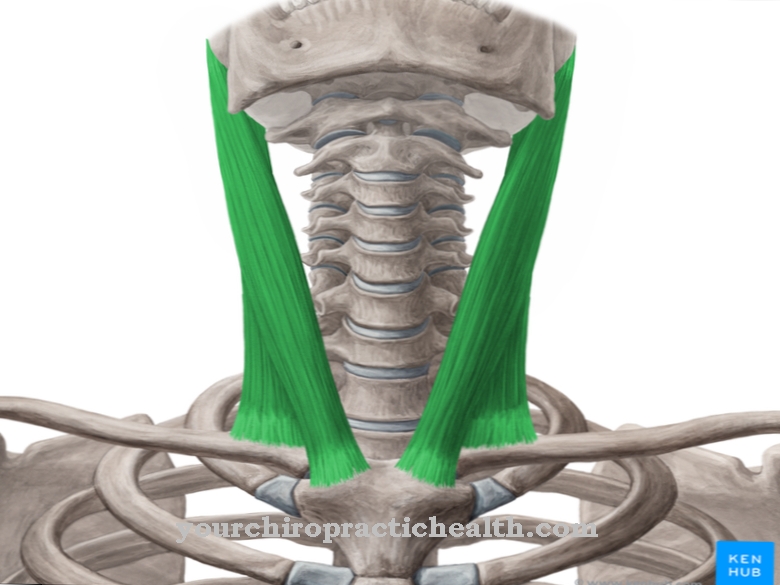The Metatarsal bones form the center of the foot skeleton. They have an important static function.
What is the metatarsal bone?
The foot skeleton consists of 3 parts with at least 26 bones, the tarsus (tarsus), the metatarsus (metatarsus) and the toes (digiti). The tarsal bones form the proximal part of the foot, the rear foot, while the toes represent the distal area, the forefoot.
The five metatarsals are articulated to the other parts and form the link between them. Similar to the toes, they are arranged next to each other and together with them form the so-called rays that diverge slightly forwards. Like the bones, these are numbered 1 to 5 from the inside out. The first ray is correspondingly the 1st metatarsal bone together with the big toe and the fifth the little toe and the 5th metatarsal bone. This construction has an important functional meaning in locomotion and statics.
Anatomy & structure
All 5 metatarsal bones have a uniform structure with three parts, base, corpus and head. The bases are articulated to the neighboring tarsal bones and to each other.
The articular surfaces in this area are all relatively flat, so there is no pronounced socket and no clearly shaped head. Above and below there are numerous small straps that secure the joints and allow little movement. Further strong ligaments stretch towards the sole of the foot, which hold all metatarsals in a bridging tension.
In the further course the elongated and thinner bodies follow, between which there are gaps that are lined with connective tissue. At the distal end there are the wider heads, which together with the toe phalanx form the metatarsophalangeal joints. The articular surfaces of the metatarsal bones are convex here, those of the basic toes are concave. Anatomically, it is therefore a ball joint with 3 degrees of freedom. Functionally, however, only movements in 2 planes are possible, since the rotation cannot be actively carried out because there are no muscles with a corresponding course.
On the 1st and fifth metatarsal bones there are proximal roughness that serve as the attachment surface for muscles that come from the lower leg and pull there. There are regularly 2 sesame bones on the underside of the head of the 1st metatarsal in the area of the metatarsophalangeal joint.
Function & tasks
The metatarsus is only slightly mobile due to its strong tension, but slight shifts up, down and to the side are possible. Mobility increases slightly towards the toes. This mobility gives the foot the ability to adapt to unevenness in the ground, an important function for maintaining balance.
The tibialis anterior muscle attaches to the base of the first metatarsal bone, which is responsible for lifting the foot with the rotation of the inner edge. This function ensures that the foot remains above the ground during the swing leg phase. The peroneus brevis muscle pulls towards the underside of the base of the 5th metatarsal. He pulls the outer edge of the foot down and turns it in the process. This function gives the foot good stability, especially when standing.
The first metatarsal is the strongest of the 5 parts. This has to do with its function when walking. Together with the big toe, the foot is imprinted from the ground at the end of the standing leg phase.
The most important function of the metatarsal bones is to participate in the arch construction of the foot. The tarsus and metatarsus are arranged so that the inner components rest on the outer ones. Two strands are created, of which only the outer one has contact with the ground, the inner one spans like a bridge between the heel bone and the heads of the metatarsals 1 - 3. This creates the bony base of the longitudinal arch of the foot.
The strong ligament securing under the metatarsal and tarsal bones forms the basis for the transverse arch of the foot, which ensures that heads 1 and 5 are the main points of contact distally. The vault structure acts as a shock absorber and is a very important static component. Impacts are buffered and the strain on the leg joints and the spine that are close to the body are significantly reduced.
Diseases
A widespread functional impairment is the insufficiency of the arch construction, in which the metatarsal bones play a major role. Due to various factors, the longitudinal or transverse arches or both can sink and partially or completely lose their buffer function.
If the longitudinal arch is affected, one speaks of the so-called arched foot, with the transverse arch of the splayfoot, because the metatarsal bones and the toes diverge laterally. This process affects on the one hand walking, but above all on the stress on the body areas above. The knee, hip and spine joints are subjected to significantly more stress because shocks are transmitted to them much more directly. Different manifestations on the left or right side can lead to changes in the leg axis or to a pelvic inclination with unilateral stress on the spine.
The metatarsal bones with their tubular structure are fundamentally in danger of breaking. Weights from above, such as a kick with the foot or a falling object, can cause metatarsal fractures, often involving multiple bones. These injuries have far-reaching consequences for the people affected, as the metatarsus must not be stressed during the healing phase. So-called march fractures are also very common. These are fatigue fractures that develop due to excessive stress on the bones. Symptoms develop gradually and initially appear as unspecific pain on exertion that is often not associated with a fracture. Only a targeted X-ray can provide clarity here.
The typical deformity of the big toe, the hallux valgus, has its origin in a deviation of the 1st metatarsal bone. With splayfoot, this bone moves further inwards. The joint surfaces of the metatarsophalangeal joint of the big toe come into a different position to one another and the big toe gives way to the outside.













.jpg)

.jpg)
.jpg)











.jpg)